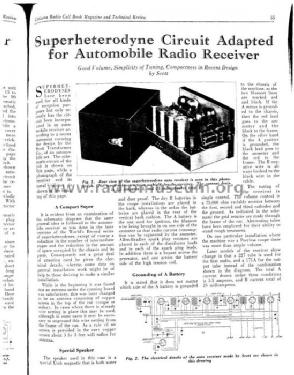Automobile Radio
Scott Radio Labs.(E.H., Transformer); Chicago (IL)
- País
- Estados Unidos
- Fabricante / Marca
- Scott Radio Labs.(E.H., Transformer); Chicago (IL)
- Año
- 1930
- Categoría
- Autoradio
- Radiomuseum.org ID
- 55382
- Numero de valvulas
- 7
- Principio principal
- Superheterodino en general
- Gama de ondas
- OM (onda media) solamente
- Tensión de funcionamiento
- Baterías recargables o pilas
- Altavoz
- Altavoz dinámico. Se desconoce si a imán permanente o electroimán.
- Material
- Metálico
- de Radiomuseum.org
- Modelo: Automobile Radio - Scott Radio Labs.E.H.,
- Forma
- Chasis (tambien de autoradio)
- Anotaciones
-
tubes are noted only once per type.
In Citizen Radio Callbook, Sept.1930.
- Ext. procedencia de los datos
- Ernst Erb
- Procedencia de los datos
- Radio Collector`s Guide 1921-1932
- Mencionado en
- E.H.Scott Radio Collectors Guide (1925-1946)
- Otros modelos
-
Donde encontrará 201 modelos, 126 con imágenes y 51 con esquemas.
Ir al listado general de Scott Radio Labs.(E.H., Transformer); Chicago (IL)
Contribuciones en el Foro acerca de este modelo: Scott Radio Labs.E.H: Automobile Radio
Hilos: 1 | Mensajes: 1
The only reference to auto radios is found in the September, 1930 issue of the Citizen’s Radio Callbook. In a single page article entitled “Superheterodyne Circuit Adapted for Automobile Radio Receiver”, Scott described his automobile radio.
The set is battery operated, obtaining ‘A’ voltage from the ignition battery, and ‘B’ cells in the back. The antenna could be either a copper mesh in the ceiling or a wire hidden in the running board. A small schematic is given, showing the following tubes: two type 27 tubes in the oscillator and second detector, three type 24 tubes for the first detector and two IF stages, a 71A as the first audio stage and a 45 as the final audio. Even using these seven tubes, Scott claimed the set only drew 25mA from the ‘B’ cells. The article leads one to believe that several sets might have been built. The last paragraph states that “later models of the receiver show change in that a 227 tube is used for the first audio, and a 171A for the output instead of the combination shown in the diagram”. The article also mentions that a special water and dust proof
Kent King, 02.Sep.06
